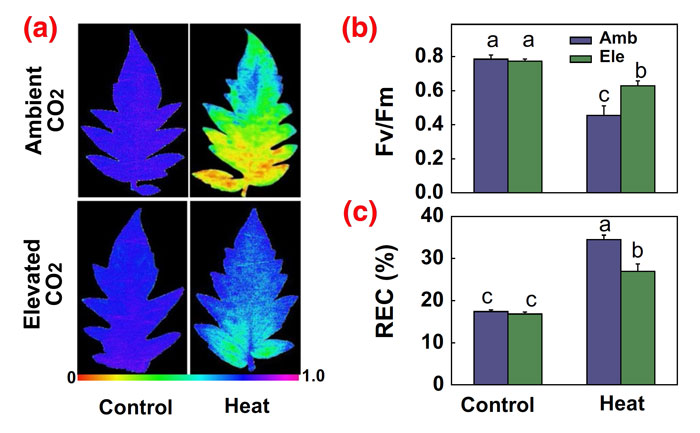| Tweet | Follow @co2science |
Paper Reviewed
Pan, C., Zhang, H., Ma, Q., Fan, F., Fu, R., Ahammed, G.J., Yu, J. and Shi, K. 2019. Role of ethylene biosynthesis and signaling in elevated CO2-induced heat stress response in tomato. Planta 250: 563-572.
High temperature stress can negatively impact the quantity and quality of crop yields by impairing photosynthetic activity, disrupting plasma membrane integrity, inducing oxidative stress and/or causing protein denaturation. Consequently, in light of model-based predictions of rising temperatures in response to increasing levels of atmospheric CO2, many are concerned that global food and nutritional security will be compromised in the near future. But how likely is this scenario?
It is well-known that to cope with heat stress, plants have evolved several mechanisms to minimize high temperature-induced damage, including the activation of antioxidants to scavenge excessive reactive oxygen species and the production of heat shock proteins (HSPs) to maintain normal protein conformation and ensure plant thermotolerance. What is more, a number of studies to date have shown that these thermotolerance mechanisms are often enhanced under elevated CO2 conditions (see the many reviews on this topic we have posted in our Subject Index under the heading Temperature x CO2 Interaction). The latest study to demonstrate as much comes from the study of Pan et al. (2019).
Working with tomato (Solanum lycopersicum cv. Ailsa Craig) plants that they grew in controlled-environment chambers under either ambient (400 ppm) or elevated (800 ppm) CO2, the eight researchers investigated the heat stress response of this key agricultural crop. At the five-leaf stage, the authors transferred the seedlings into the study chambers under the two CO2 concentrations. Then, after two days of acclimation, they subjected half the plants to heat stress (42°C day/night temperature versus a control 25°C day/night temperature) for one day, after which time they conducted a series of tests to determine the ability of elevated CO2 to alleviate the stress.
In discussing their findings, Pan et al. report that elevated CO2 "attenuated high temperature-induced damages [in the photosynthetic apparatus and membrane integrity] as evidenced by a significant increase in the maximum photochemical efficiency of photosystem II (Fv/Fm) and a drastic decrease in relative electrical conductivity (REC)" relative to plants exposed to heat stress under ambient CO2 conditions (see Figure 1). Furthermore, by analyzing the response of key genes known to enhance plant tolerance to heat stress (notably ethylene and heat shock proteins), the authors obtained "convincing evidence" that both ethylene and heat shock proteins were significantly induced by elevated CO2 and helped to ameliorate heat stress.
In highlighting this key stress-alleviating thermotolerance benefit of atmospheric CO2 enrichment, the above findings suggest that the plants of tomorrow will be better equipped to withstand high temperatures so as to help ensure greater crop yields in the years and decades ahead.

Figure 1. Effects of elevated CO2 on tomato plant responses to heat stress. Tomato plants were acclimated in ambient (400 ppm) or elevated (800 ppm) CO2 conditions for 2 days before exposure to heat stress (42°C) or control temperature (25°C). Panel a displays images of maximum photochemical efficiency of photosystem II (Fv/Fm) and Panel b presents their quantitative values measured after 1 day of heat stress treatment. The color gradient scale at the bottom indicates the magnitude of the fluorescence signal represented by each color. Panel c displays the relative electrical conductivity (REC) in tomato leaves after 1 day of heat stress treatment in ambient or elevated CO2 conditions. The results in b and c are presented as mean values and error bars indicate standard deviation (SD), in which n = 6 and 3, respectively. One-way ANOVA test followed by Tukey's post hoc test was performed, and different letters indicate significant differences between treatments (P < 0.05) according to Tukey's test. Source: Pan et al. (2019).




